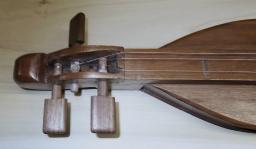Top/Back Thickness and Sustain?
Instruments- discuss specific features, luthiers, instrument problems & questions
I don't measure! I "feel of" the wood panel as I'm thickness sanding to the right thickness. Flexing the panel and from experience knowing the right mass I'm looking for for a particular tone. Harder denser woods can be sanded much thinner than a softer less dense piece.
As for sustain? Panel thickness is just one variable factor in a multitude of factors involved. String selection, nut and bridge hardness or softness, nut and bridge placement, over all mass of the piece, wood selection, possibly the finish, intonation, and so on.
If sustain is what you look for, I'd try harder more dense woods sanded to around .090 if you can, harder nut and bridge, and possibly a zero fret?
Some place to start....


